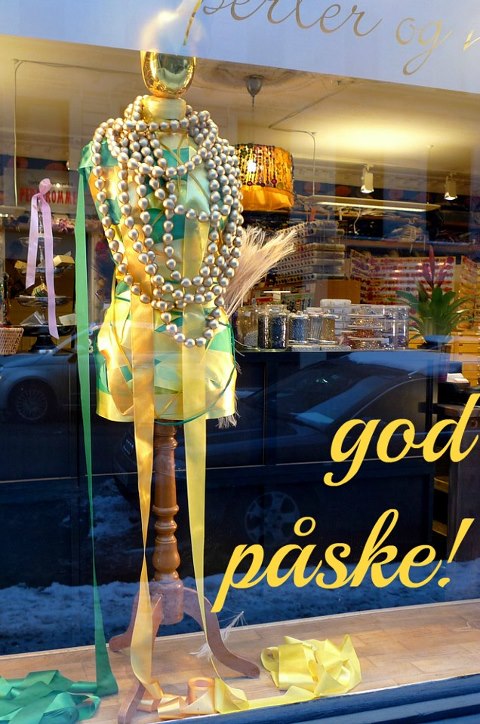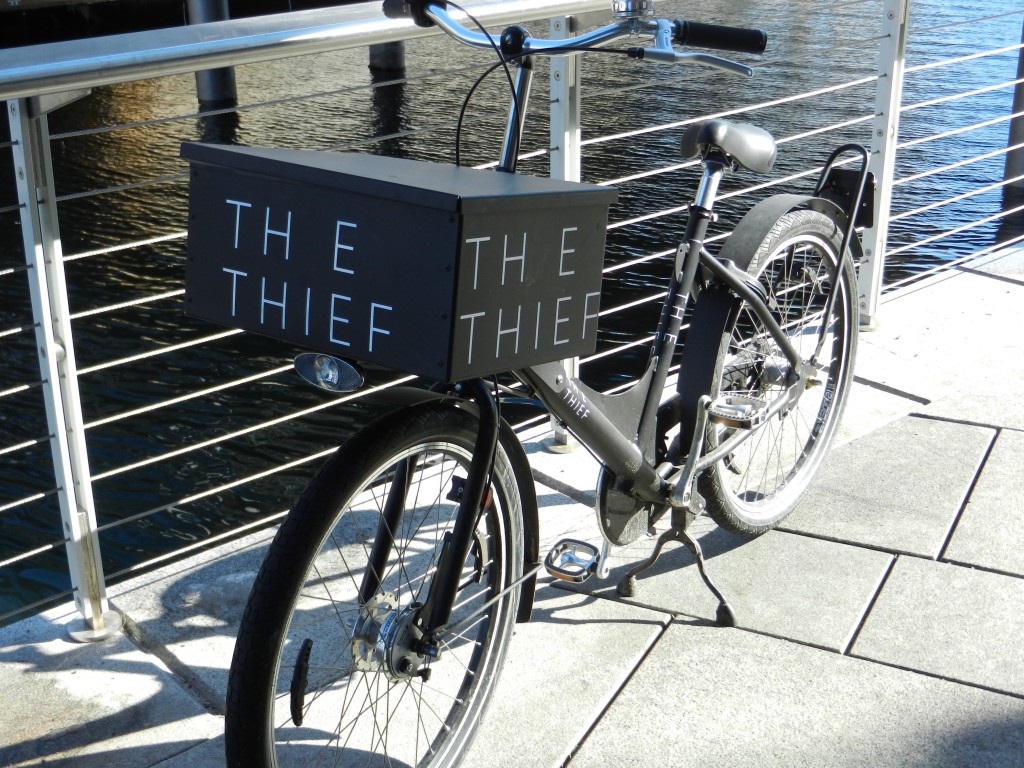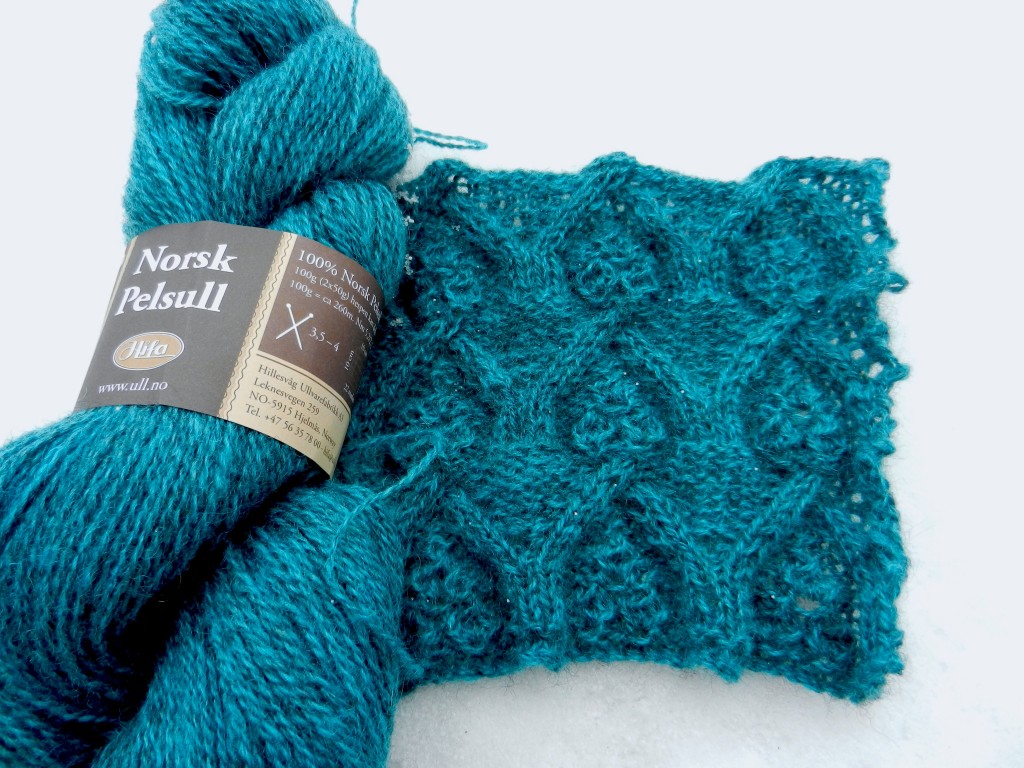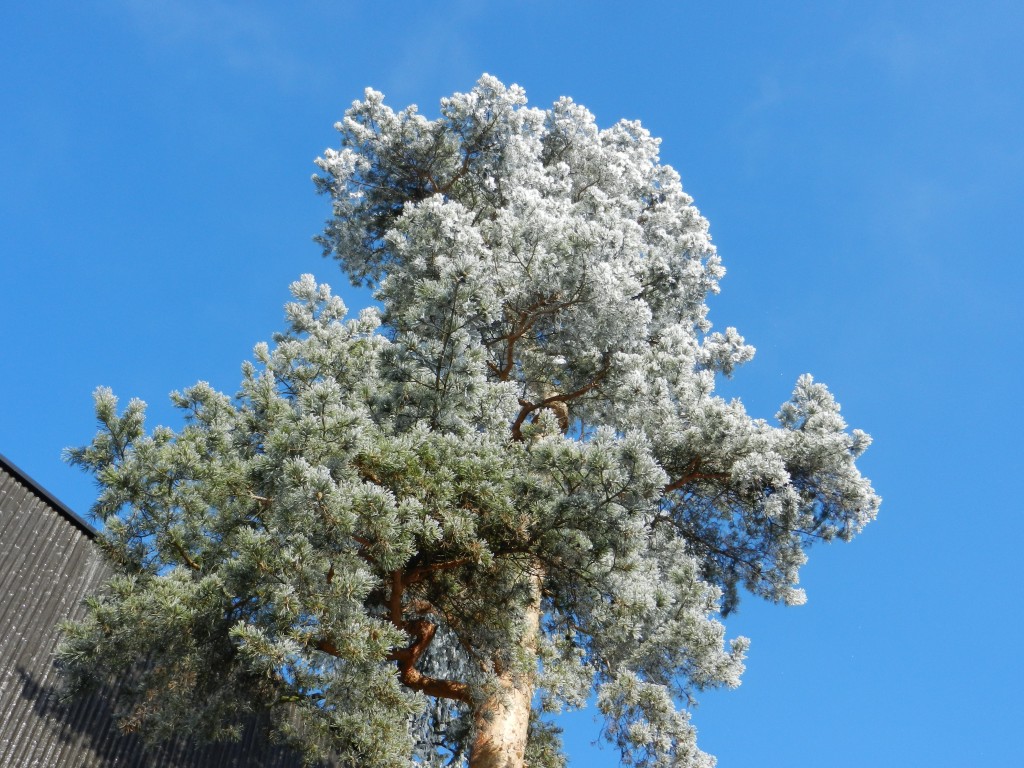It is Easter, and I am on a button hunt. I do know that it is the not the kind of hunt you are supposed to be on during Easter, but not unusual for me though! Where do I go? My favorite button treasure trove is Perlehuset/The beading house in Grønnegate off Hedgehaugsveien in Oslo – here: perlehuset. It is a tiny shop but do not be fooled the selection is off another world and their warehouse is numerous times the size of the shop – yes, I do know because I have been there. You can read about my exploration of it here: thousands-of-tons-of-buttons-and-beads. Of course I have to check out their latest selection of beads as well while I am there – their latest offerings on Facebook has made me very curious indeed: semi precious stones on a string. No, not for knitting but for making jewelry. Do study their tempting window display below. God Påske is Norwegian for Happy Easter and that is what I wish you all!
Monthly Archives: March 2013
The Thief in Oslo
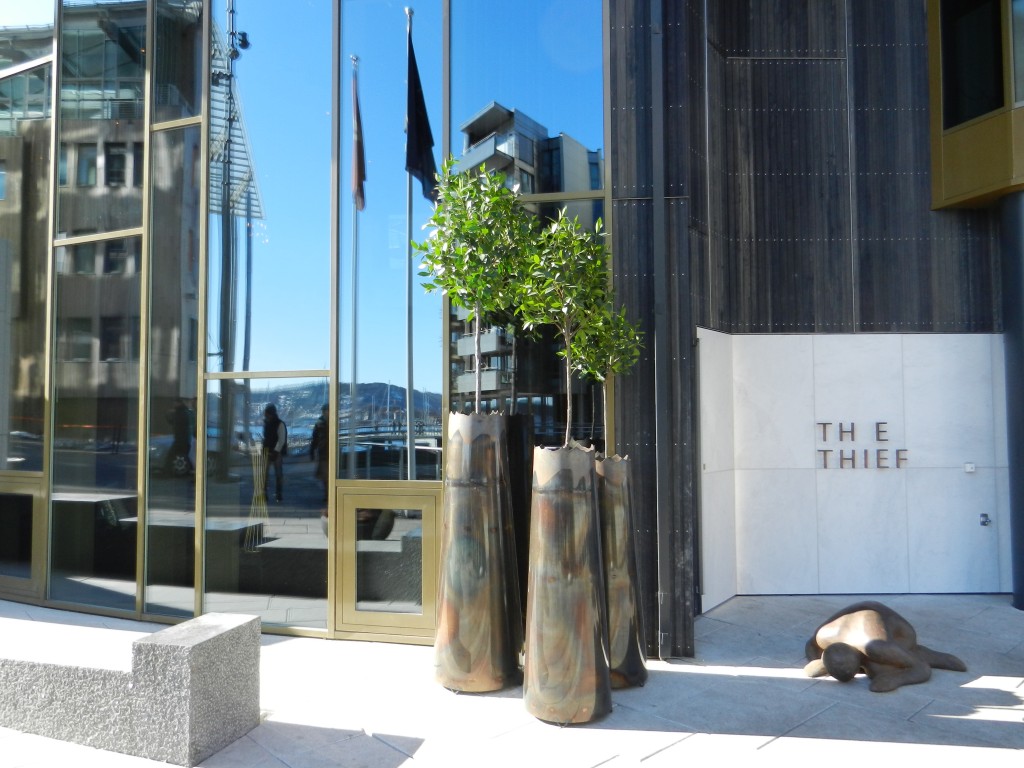 Who? Not who, but what; A new luxurious hotel located at the waterfront at Aker Brygge/Wharf. Named The Thief because of its location at Tjuvholmen/Thief Island which used to be a home to criminals and shady dealings back in the 18th century but has now been turned into a prime location with restaurants and art galleries. My husband and I were curious to check it out, after reading about it in the newspapers. Sunday brought glorious but cold weather as you can see reflected in the windows of the reception at The Thief. I admired and enjoyed the art outside and inside the hotel, curated by Sune Nordgren, several pieces on loan from the nearby Astrup Fearnley Museum. Yes, a sponsorship agreement, highly unusual for an hotel. He claims: “Redefining hotel art is about giving the guests quality experiences, causing reflection and perhaps changing their perception of reality for a brief moment.” Thief Artists in 2013 include Peter Blake, Magne Furuholmen, Antony Gormley, Marianne Heske, Kjell Nuppen and Andy Warhol among others. See the complete list here: thethief
Who? Not who, but what; A new luxurious hotel located at the waterfront at Aker Brygge/Wharf. Named The Thief because of its location at Tjuvholmen/Thief Island which used to be a home to criminals and shady dealings back in the 18th century but has now been turned into a prime location with restaurants and art galleries. My husband and I were curious to check it out, after reading about it in the newspapers. Sunday brought glorious but cold weather as you can see reflected in the windows of the reception at The Thief. I admired and enjoyed the art outside and inside the hotel, curated by Sune Nordgren, several pieces on loan from the nearby Astrup Fearnley Museum. Yes, a sponsorship agreement, highly unusual for an hotel. He claims: “Redefining hotel art is about giving the guests quality experiences, causing reflection and perhaps changing their perception of reality for a brief moment.” Thief Artists in 2013 include Peter Blake, Magne Furuholmen, Antony Gormley, Marianne Heske, Kjell Nuppen and Andy Warhol among others. See the complete list here: thethief
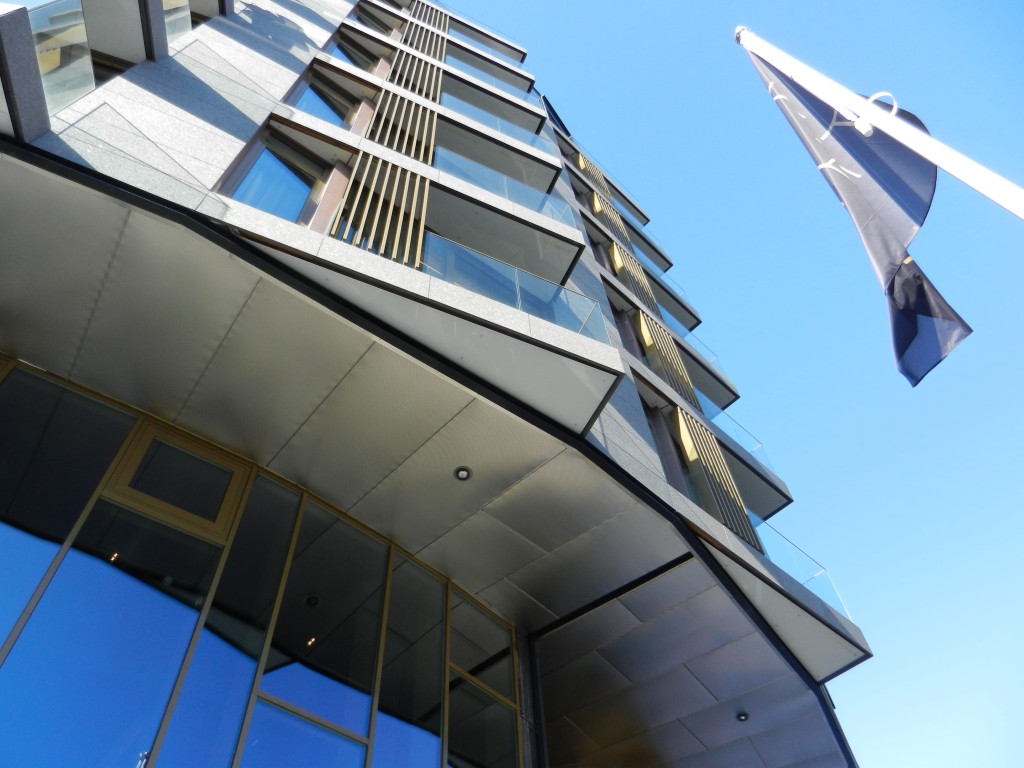 The architects is the award winning Mellbye Architects: “The facade has been given a dark expression giving the arriving guest a bit of surreal feeling. It does take a few blinks to realise it is an hotel and not a mirage or computer rendering.” Granite, black and dark colors and gold distinguishes the five star hotel from its lighter design hotel cousins. One review criticized the dark interior and compared its style with its owner Petter A. Stordalen. More on him in this interesting article: To Catch a Thief: madebyoriginals. And yes I agree, his love of leather trousers and jewellry does make him fit in extremely well. But I would so much rather visit such a dark innovative hotel any day than a neutral one…
The architects is the award winning Mellbye Architects: “The facade has been given a dark expression giving the arriving guest a bit of surreal feeling. It does take a few blinks to realise it is an hotel and not a mirage or computer rendering.” Granite, black and dark colors and gold distinguishes the five star hotel from its lighter design hotel cousins. One review criticized the dark interior and compared its style with its owner Petter A. Stordalen. More on him in this interesting article: To Catch a Thief: madebyoriginals. And yes I agree, his love of leather trousers and jewellry does make him fit in extremely well. But I would so much rather visit such a dark innovative hotel any day than a neutral one…
You will find more interesting stories in The Thief’s web magazine here: thethief. And finally, I do like their mantra: At The Thief we treat rock stars as guest and guest as rock stars…
New Design: Cable On Scarf
I finished this scarf a few months back, but had initially planned to use it as an accessory to the Arcade Vest. But since I opted for a round neck instead of a v-neck, and its natural light grey color does not make for a perfect pair with the turquoise, it is on its own – at least for now. The Cable On Scarf is reversible made up of rib stitches instead of the usual stocking stitches, framed by double moss on each side. The horn shaped cables adds texture and depth to this generous scarf. Why not wear it as a decorative warm collar. It is knitted in the classic natural grey shade of the beautiful Norsk/Norwegian Pelsull/Furyarn by Hifa using a 3.5 mm/US 4. Available here at: ull, see the first colours below, another 7 have been added since yarn launch. The pattern has been bought by the Norwegian magazine Familien/The Family but will not be published until the autumn since spring is on its way.
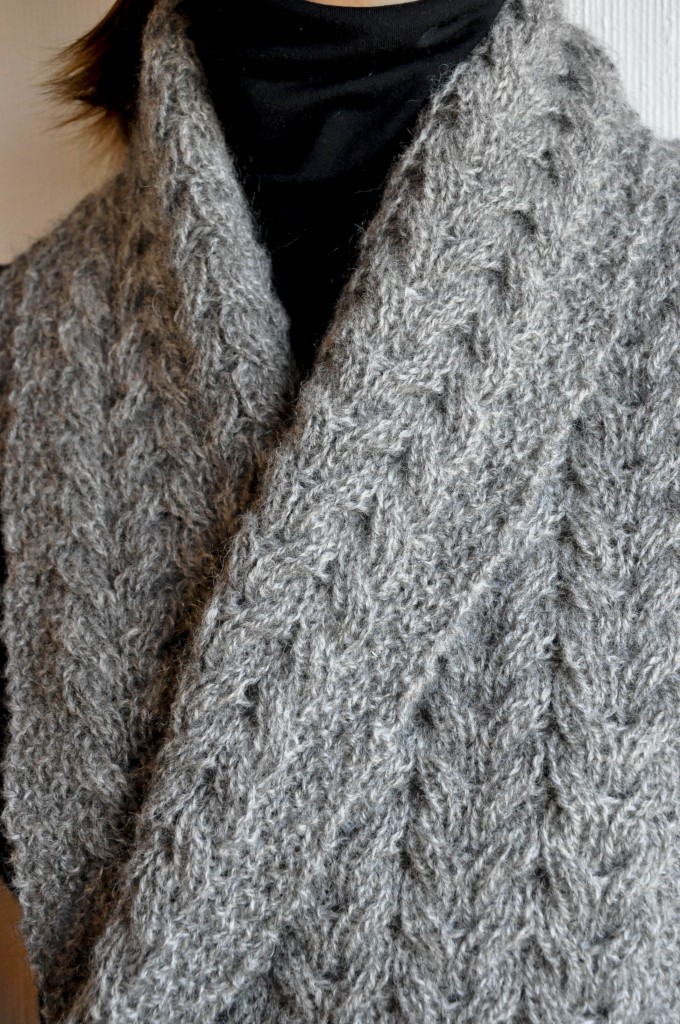 I will show you the professional photo when it is ready, probably not until early autumn. The pattern will be available in my Ravelry store in both English and Norwegian, a year after publication of the magazine. I am working on more designs, but did not make it into to Twist Collective fall 2013 issue only onto the short list, so I am not discouraged and will try again!
I will show you the professional photo when it is ready, probably not until early autumn. The pattern will be available in my Ravelry store in both English and Norwegian, a year after publication of the magazine. I am working on more designs, but did not make it into to Twist Collective fall 2013 issue only onto the short list, so I am not discouraged and will try again!
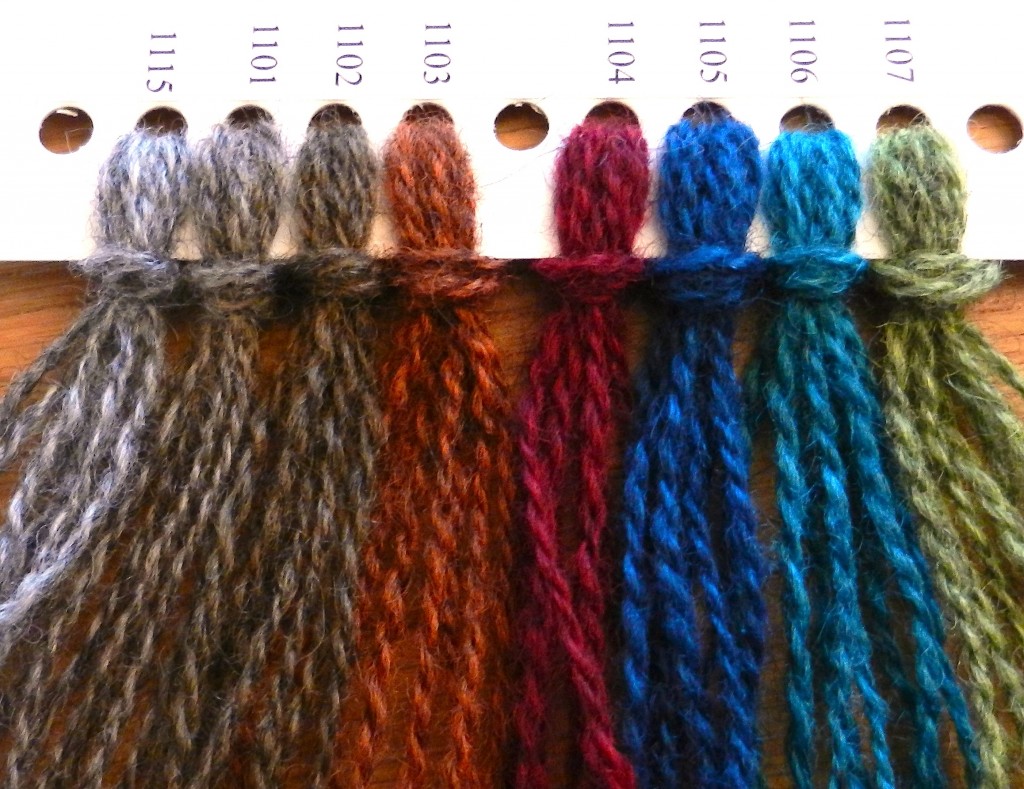 Do take a look at Nina’s Milanese Shawl knitted in a stunning brown shade of Wollmeise Lace again with homemade covered buttons here: fiberandart. The pattern is in my Norwegian (and Finnish) knitting book, and sold in English in my Ravelry store here: linda-marveng. In addition, she – a speedy knitter – has also knitted the Open Triangles Cowl and Wristwarmers from the pattern published in Familien issue 2, and I am so thrilled with her selection of designer, look at: fiberandart.
Do take a look at Nina’s Milanese Shawl knitted in a stunning brown shade of Wollmeise Lace again with homemade covered buttons here: fiberandart. The pattern is in my Norwegian (and Finnish) knitting book, and sold in English in my Ravelry store here: linda-marveng. In addition, she – a speedy knitter – has also knitted the Open Triangles Cowl and Wristwarmers from the pattern published in Familien issue 2, and I am so thrilled with her selection of designer, look at: fiberandart.
Yarn Newsletter – Jimmy Beans Wool
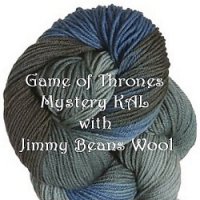 I have recently discovered Jimmy Beans Wool online – yes, I was looking for more yarn, Tosh DK actually, and found it – and hence their excellent newsletter. It has a magazine feel with an incredible amount of useful information. Updates on their own KALs – currently Game of Thrones Mystery KAL (Knit-along), based on the popular television series by HBO (for more info see the page on Ravelry game-of-thrones-mystery-kal). New yarns with detailed descriptions and photos, latest in inspiration – a great way of keeping updated on books and pattern booklets. It even includes a free pattern in addition to Terry’s Tips; usually a video clip; this time it is short rows with a wrap and turn. Of course it includes a sale section, staff (known as Beans) projects on needles, meet a Bean and an update on events. Amazing, how well informed I feel after just minutes of reading. The February newsletter tempted me with new luxurious yarns from Lotus Yarns made by pure mink and pure yak fibers. Yes, I would very much like to test those two; how they knit up and feel on my hands! Take a look here: newsletter and see if you agree. They are on my list of yarns to test, and as you probably guessed they are at the higher end of the price range. I do admit it, I am a yarn snob and take great pleasure in reading about new luxurious yarns!
I have recently discovered Jimmy Beans Wool online – yes, I was looking for more yarn, Tosh DK actually, and found it – and hence their excellent newsletter. It has a magazine feel with an incredible amount of useful information. Updates on their own KALs – currently Game of Thrones Mystery KAL (Knit-along), based on the popular television series by HBO (for more info see the page on Ravelry game-of-thrones-mystery-kal). New yarns with detailed descriptions and photos, latest in inspiration – a great way of keeping updated on books and pattern booklets. It even includes a free pattern in addition to Terry’s Tips; usually a video clip; this time it is short rows with a wrap and turn. Of course it includes a sale section, staff (known as Beans) projects on needles, meet a Bean and an update on events. Amazing, how well informed I feel after just minutes of reading. The February newsletter tempted me with new luxurious yarns from Lotus Yarns made by pure mink and pure yak fibers. Yes, I would very much like to test those two; how they knit up and feel on my hands! Take a look here: newsletter and see if you agree. They are on my list of yarns to test, and as you probably guessed they are at the higher end of the price range. I do admit it, I am a yarn snob and take great pleasure in reading about new luxurious yarns!
New Design: Arcade Vest
Yes, it is finally finished (= FO: finished object) and I am pleased with the result. A straight vest inspired by Haider Ackermann’s strict architectonic style and jewel colors. Arcades made by twists and cables, framed by double moss/seed stitch and outlined by an I-cord edge around neck and armholes. The double front adds volume and shape. You can close it as you wish; with a shawl pin, brooch or a belt. Stylish when closed at the top for an asymmetrical look. Using a 3.5mm/US 4, it has been a delight to knit in the newly launched Norsk Pelsull/Norwegian Furwool, a pure wool with a subtle sheen available in stunning melange shades here: ull.no. I am pleased to announce that the pattern has been sold to the Norwegian magazine Familien/The Family and will be published shortly – before the autumn, date to be confirmed. The pattern will be available in English in my Ravelry store (ravelry) a year after magazine publication – in the mean time you can queue it…
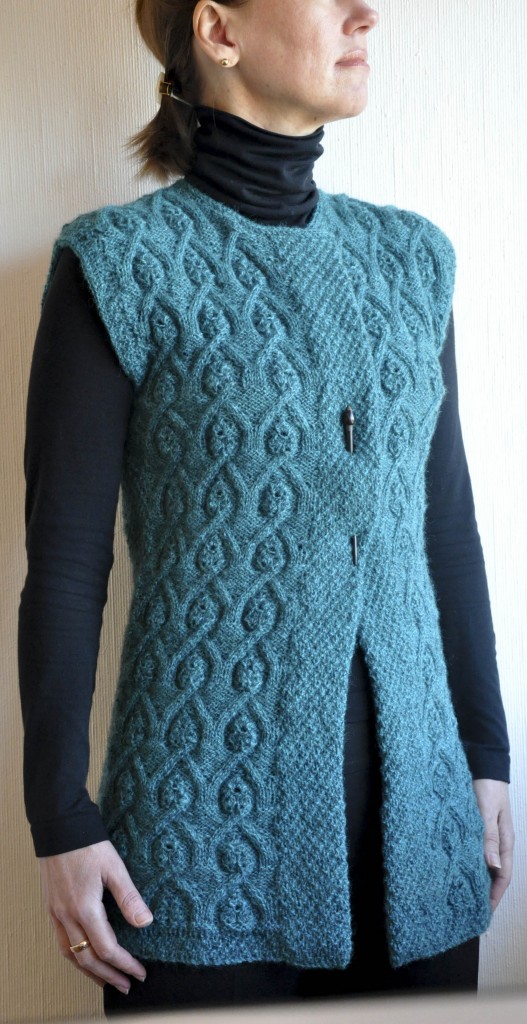 I needed time to consider what type of edge I should chose on this project – see my work-in-progress-wip post. In the end, it was trial and error. Making an edge on a swatch does not always solve the edging issue. I found the double moss/seed stitch edging at the front too flimsy and folded it completely – one of the options I had considered from the outset. The neck, I decided was perfect with an I-cord cast/bind off, for definition and a bit of added volume. I tried the same at the armhole but realised that the armhole needed a bit of shaping in addition so I chose to knit several rounds of moss/seed stitch first with a few decreases and then an I-cord cast/bind off. I considered adding buttons to the front, but prefer to wear it asymmetrical hence I made no buttonholes. A good option would be to add a decorative button – or more – with a snap fastener at the back, I believe.
I needed time to consider what type of edge I should chose on this project – see my work-in-progress-wip post. In the end, it was trial and error. Making an edge on a swatch does not always solve the edging issue. I found the double moss/seed stitch edging at the front too flimsy and folded it completely – one of the options I had considered from the outset. The neck, I decided was perfect with an I-cord cast/bind off, for definition and a bit of added volume. I tried the same at the armhole but realised that the armhole needed a bit of shaping in addition so I chose to knit several rounds of moss/seed stitch first with a few decreases and then an I-cord cast/bind off. I considered adding buttons to the front, but prefer to wear it asymmetrical hence I made no buttonholes. A good option would be to add a decorative button – or more – with a snap fastener at the back, I believe.
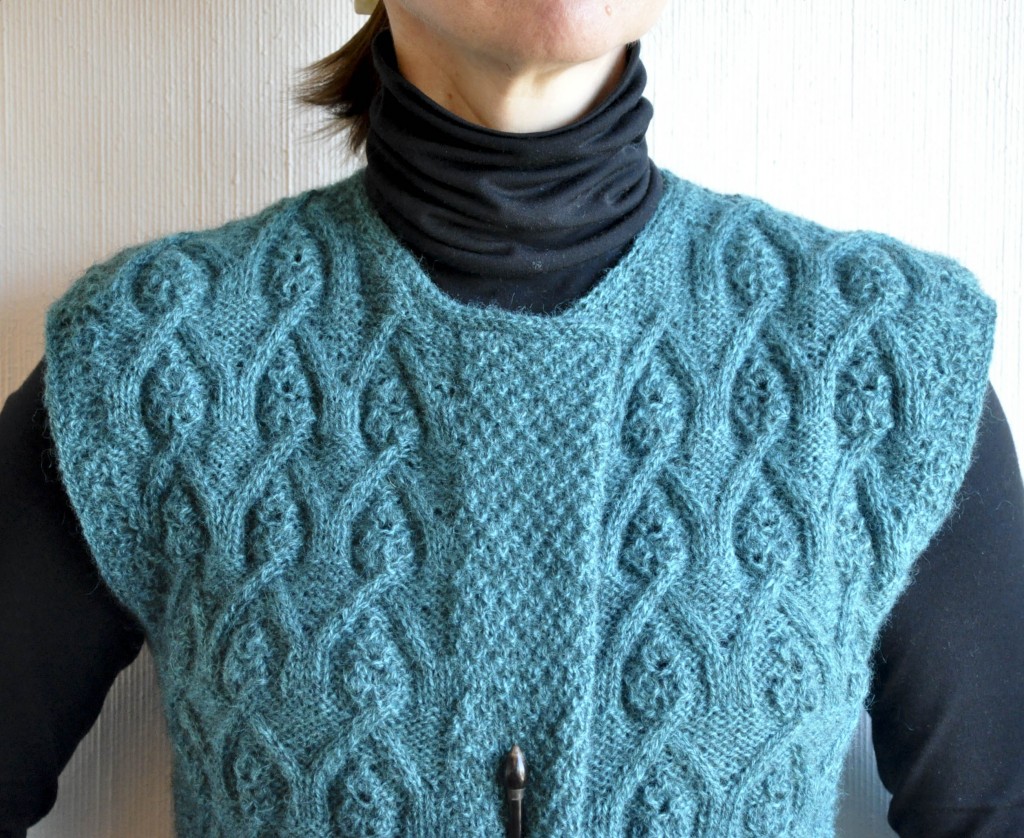 The vest is knitted in one piece, half of each moss/seed stitch panel is folded back as interfacing – knitted together at the top and sewn in place along the WS. The neck stitches are picked up and cast/bind off with an I-cord. While the armholes are similar but worked in the round with a few rows of moss/seed stitch first before the cast/bind off. The arcade pattern – yes, it is from Barbara Walker’s second-treasury-of-knitting-patterns – consists of twists, increased and decreased stitches in the middle and is quite difficult to read but does feel like working with lego project: building arcades. It did not take long until I learned the stitch pattern by heart. That is my type of stitch pattern!
The vest is knitted in one piece, half of each moss/seed stitch panel is folded back as interfacing – knitted together at the top and sewn in place along the WS. The neck stitches are picked up and cast/bind off with an I-cord. While the armholes are similar but worked in the round with a few rows of moss/seed stitch first before the cast/bind off. The arcade pattern – yes, it is from Barbara Walker’s second-treasury-of-knitting-patterns – consists of twists, increased and decreased stitches in the middle and is quite difficult to read but does feel like working with lego project: building arcades. It did not take long until I learned the stitch pattern by heart. That is my type of stitch pattern!
Signature Knitting Needle Revelation
I have had a knitting revelation; I have tested my new jewel colored knitting needles, made of aircraft quality aluminum from Signature Needle Arts, and they are marvelous! I have previously been an addict of Addi Lace circular needles, with their pointy tips and brass coating but I am now a Signature addict. Because it feels like I have a control I never knew I did not have up to now – they give such precision and feel so extremely good in my hand that I regret not ordering them years ago. So I am catching up quickly now. The circulars have a smooth cable to needle transition, laser marked US and mm sizes and a flexible memory resistant cable. They come with a lifetime guarantee – which would not work for bamboo needles in small sizes of which I have broken a large number, nor interchangeable ones from Knit Pro where the joint snaps. At Signature you create your own circular needle by choosing either a Stiletto – a sharp point – or a Middy – a blunter point, the length of your needle tip 4 to 6″/10 til 15 cm depending on size and overall length. I could not resist to have mine custom monogrammed with my name – ideal for workshops, making sure I get mine back. Take a look and marvel: signatureneedlearts.
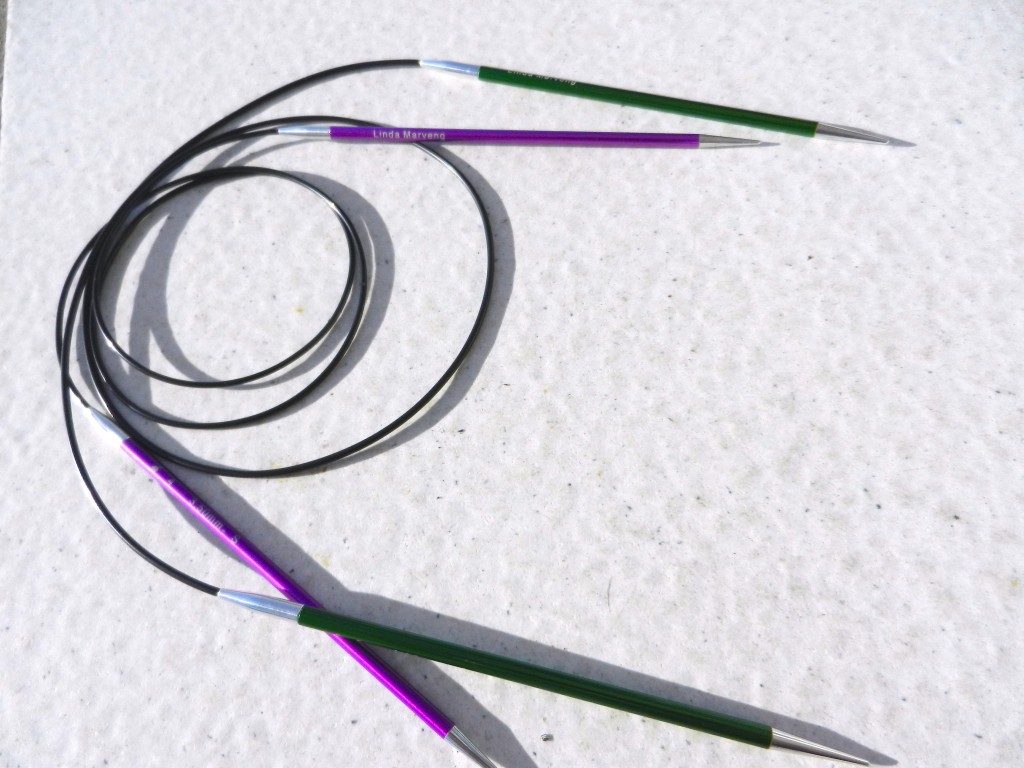 Expensive compared to other knitting needles – you say. Absolutely, but then I never had knitting needles that blew my mind either! So they are worth every penny even ordering from the US to Norway with all the extra charges involved. I never use straight needles only double pointed needles when I make an I-cord, because I find them so much easier to work with, take with me so I can knit on the train, and I tend not to raise my shoulders when knitting as I do with straights.
Expensive compared to other knitting needles – you say. Absolutely, but then I never had knitting needles that blew my mind either! So they are worth every penny even ordering from the US to Norway with all the extra charges involved. I never use straight needles only double pointed needles when I make an I-cord, because I find them so much easier to work with, take with me so I can knit on the train, and I tend not to raise my shoulders when knitting as I do with straights.
I have also tested other brands and other types of needles from metal from Inox, plastic from Prym, bamboo from Clover, metal from Hiya Hiya, cubic rosewood needles from Knit Pro, interchangeable from Knit Pro and rosewood needles from Lantern Moon. My second favorite is the circulars in rosewood – solid, not hollow as the Knit Pro ones – by Lantern Moon, while Addi Lace is now third. The distance between my first and second favorite is huge, but it does depend on the kind of fiber I am working with; especially mohair demands a wooden needle so the yarn does not slide off the needle too easily. At the moment I am working with a lush merino from Madeline Tosh and adore my new Signature needles. I had to share my bliss!
Frosting
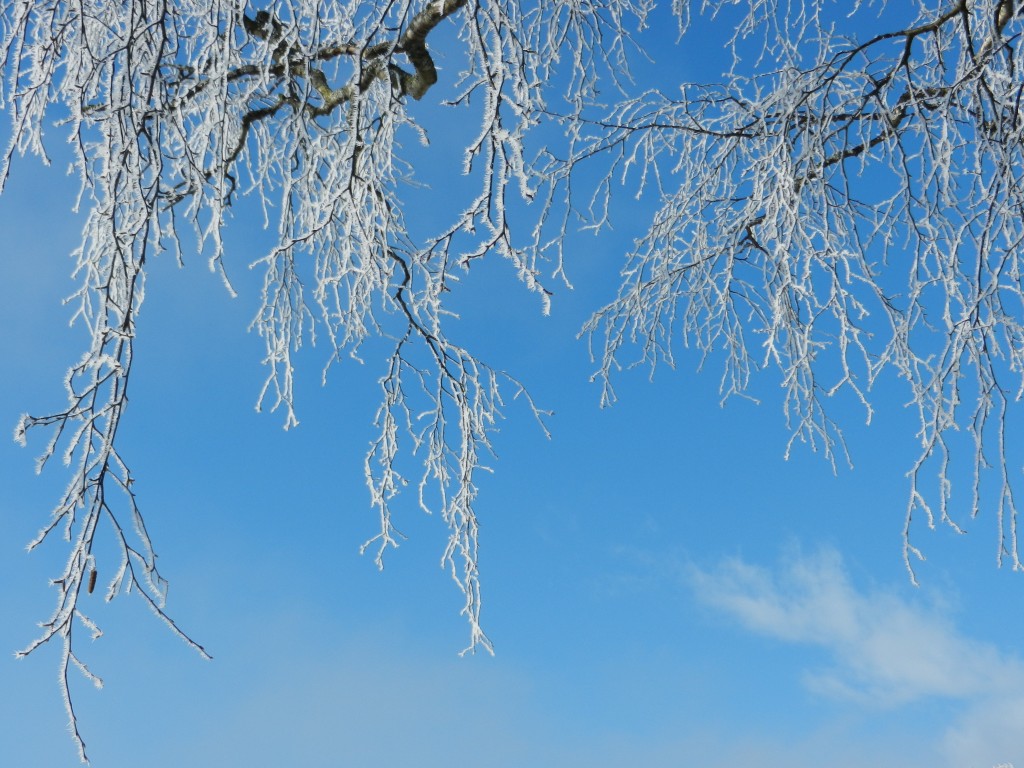 The snow is melting, but we still have days when the frost grips leaves, branches and trees. I love the look of the frost – frozen in time but only for a very short time and photographed the trees in our garden. The contrast to the striking blue sky is ever so dramatic, and so is the mix of textures when you study the frost in detail.
The snow is melting, but we still have days when the frost grips leaves, branches and trees. I love the look of the frost – frozen in time but only for a very short time and photographed the trees in our garden. The contrast to the striking blue sky is ever so dramatic, and so is the mix of textures when you study the frost in detail.
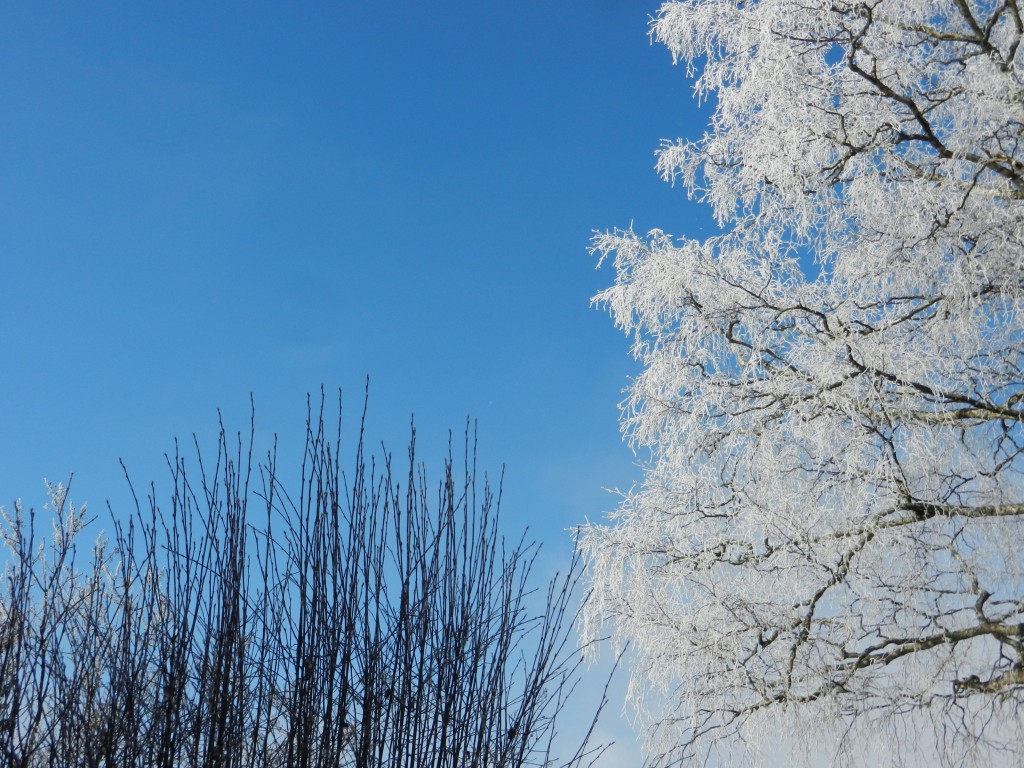 Even the pine tree next to our house had a frosting on for a few hours, before it melted away. Spring is definitely on its way and I for one, crave some more colours.
Even the pine tree next to our house had a frosting on for a few hours, before it melted away. Spring is definitely on its way and I for one, crave some more colours.
A Second Treasury of Knitting Patterns
This book, written by Barbara G. Walker – an influential knitting expert, author and feminist – was first published in 1970 by Schoolhouse Press and has been in demand ever since. It is part of a series of four encyclopedic reference books, and it is my favorite of the series – which I just had to buy after flicking through one. Available at schoolhousepress, amazon and at norli. It is fittingly dedicated “To the further enrichment of a beloved craft”. In her introduction she writes, “Some of the patterns in the this book are contemporary originals…Other patterns are traditional…I have resurrected these from old, forgotten books and translated them into modern terminology…Still other patterns have come from other areas of the world…Like music, knitting truly is a universal language.”
 To give you an idea of the tremendous asset it is I will list the chapters: Knit-Purl Combinations, Slip-Stitch Pattern, Slip-Stitch Color Patterns, Mosaic Patterns, Fancy Color Patterns, Fancy Texture Patterns, Twist-Stitch Patterns, Cables, Cable-Stitch Patterns, Yarn-Over Patterns, Eyelets, Lace, Lace Panels and Insertions, Borders and Edgings. 700 different stitch patterns to chose from, presented with black and white photos with written instructions, whether you design or want ideas to make your own sampler – testing out the different stitch patterns – whether it is going to be a scarf, baby blanket or bed spread.
To give you an idea of the tremendous asset it is I will list the chapters: Knit-Purl Combinations, Slip-Stitch Pattern, Slip-Stitch Color Patterns, Mosaic Patterns, Fancy Color Patterns, Fancy Texture Patterns, Twist-Stitch Patterns, Cables, Cable-Stitch Patterns, Yarn-Over Patterns, Eyelets, Lace, Lace Panels and Insertions, Borders and Edgings. 700 different stitch patterns to chose from, presented with black and white photos with written instructions, whether you design or want ideas to make your own sampler – testing out the different stitch patterns – whether it is going to be a scarf, baby blanket or bed spread.
You do not need to be an experienced knitter to enjoy and use it. An ideal way of learning to knit different stitch patterns and how to read patterns. The book contains a detailed description of terms and abbreviations, how to adapt patterns for circular knitting and a handy index. Each pattern will tell you how many to cast on to make 1 pattern repeat as well as it multiples so you can calculate to your own size. My copy is so full of post-it notes that I have now started using yarns in different color to mark my selection of patterns to test and use. I think Barbara G. Walker will approve.
Professionally Photographed: Patent Poncho
As promised, I am pleased to present the latest of my finished designs beautifully photographed by Esten Borgos on behalf of the Norwegian magazine Familien/The Family which will publish my Patent Poncho together with the Cablewing Sweater and cowls in the spring. Unfortunately, I do not have a publication date yet, but will keep you posted. The square poncho, made in an oversized sweater style with longs splits in the side to make it less voluminous. It is knitted in panels of Fisherman’s rib and cables in a beautiful camelbrown Ask – Hifa 2, a pure wool with plenty of bounce, available in stunning colors at ull using a 3 mm/US 2.5.
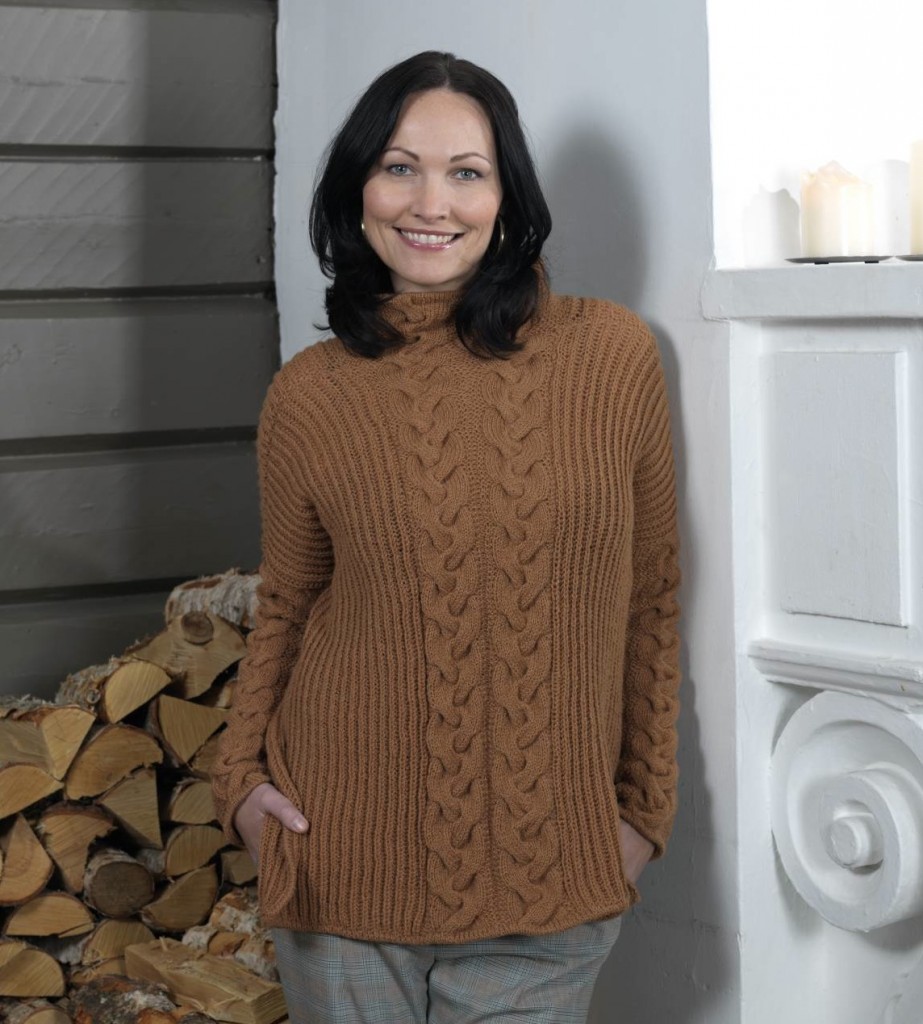 The poncho is one size, but the length can easily be adjusted; bust measures 150 cm/59″, length measures 67 cm/26¼” and upper arm measures 44 cm/17¼”. See more photos, taken by my husband, here: new-design-patent-poncho. All panels are of the same length except for the front cable panel which is a pattern repeat shorter, than the back to make space for a larger round collar. I knitted two panels in Fisherman’s rib at the same time using a circular needle. They are knitted a few cm longer than finished length because the pattern makes the panel stretch more sideways than longways. I enjoyed knitting the cable – more than the Fisherman’s rib – and loved the contrast between the two stitch patterns. I also wanted to add a bit of sleeves in cables so that you can move your arms about. I find it essential to not have restricted arm movement! So I can knit.
The poncho is one size, but the length can easily be adjusted; bust measures 150 cm/59″, length measures 67 cm/26¼” and upper arm measures 44 cm/17¼”. See more photos, taken by my husband, here: new-design-patent-poncho. All panels are of the same length except for the front cable panel which is a pattern repeat shorter, than the back to make space for a larger round collar. I knitted two panels in Fisherman’s rib at the same time using a circular needle. They are knitted a few cm longer than finished length because the pattern makes the panel stretch more sideways than longways. I enjoyed knitting the cable – more than the Fisherman’s rib – and loved the contrast between the two stitch patterns. I also wanted to add a bit of sleeves in cables so that you can move your arms about. I find it essential to not have restricted arm movement! So I can knit.
PS: When the pattern rights are released after one year, I will publish the patterns for sale in both Norwegian and English from my Ravelry pattern store, see ravelry.com/designers/linda-marveng.

